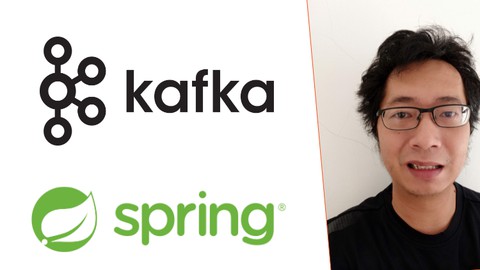
Java Spring & Apache Kafka Bootcamp – Basic to Complete
Java Spring & Apache Kafka Bootcamp – Basic to Complete, available at $109.99, has an average rating of 4.48, with 340 lectures, based on 923 reviews, and has 10314 subscribers.
You will learn about Setup a basic Kafka development environment Learn & implement Apache Kafka concepts : topic, partition, publish / consume Kafka Stream : Real-time data transformation Basic error handling in Kafka Learn & implement Java programs to handle asynchronous data integration among multiple systems using Apache Kafka How Kafka fit on microservice architecture This course is ideal for individuals who are Developers who want to learn how Apache Kafka can fit into their enterprise systems, especially when integrating data among multiple systems, in near-real-time fashion or Anyone who wants to know the basic ways of messaging system, or publish-subscribe pattern or Technical Manager / Architect that find a way to integrate data from one system to another It is particularly useful for Developers who want to learn how Apache Kafka can fit into their enterprise systems, especially when integrating data among multiple systems, in near-real-time fashion or Anyone who wants to know the basic ways of messaging system, or publish-subscribe pattern or Technical Manager / Architect that find a way to integrate data from one system to another.
Enroll now: Java Spring & Apache Kafka Bootcamp – Basic to Complete
Summary
Title: Java Spring & Apache Kafka Bootcamp – Basic to Complete
Price: $109.99
Average Rating: 4.48
Number of Lectures: 340
Number of Published Lectures: 242
Number of Curriculum Items: 340
Number of Published Curriculum Objects: 242
Original Price: $19.99
Quality Status: approved
Status: Live
What You Will Learn
- Setup a basic Kafka development environment
- Learn & implement Apache Kafka concepts : topic, partition, publish / consume
- Kafka Stream : Real-time data transformation
- Basic error handling in Kafka
- Learn & implement Java programs to handle asynchronous data integration among multiple systems using Apache Kafka
- How Kafka fit on microservice architecture
Who Should Attend
- Developers who want to learn how Apache Kafka can fit into their enterprise systems, especially when integrating data among multiple systems, in near-real-time fashion
- Anyone who wants to know the basic ways of messaging system, or publish-subscribe pattern
- Technical Manager / Architect that find a way to integrate data from one system to another
Target Audiences
- Developers who want to learn how Apache Kafka can fit into their enterprise systems, especially when integrating data among multiple systems, in near-real-time fashion
- Anyone who wants to know the basic ways of messaging system, or publish-subscribe pattern
- Technical Manager / Architect that find a way to integrate data from one system to another
New Update 2 :
Learn everything about Kafka in single course:
-
Rewrite all lectures for better audio quality
-
Update Spring version to 2.6.x
-
Update Kafka version to 3.x
-
Newer alternative for deprecated syntax on Spring Kafka
-
Learn about Kafka Connect. How it can fit into system architecture, and how easy to ingest data from / to kafka, using Kafka Connect. With real-world sample hands-on
-
Learn about KsqlDB. Howit can helps speed up kafka usage, even for a team who does not know Java programming language
-
The whole sections are integrated each other. Learn how to integrate Kafka Connect + Kafka Schema Registry + Kafka Stream + KsqlDB
New Update :
-
Learn how to use avro with spring kafka, manage avro schema with confluent schema registry
-
Write producer & consumer without coding using kafka REST Proxy
-
Find out how Kafka fit on microservice architecture.
-
How to use Kafka along with REST API & Database transaction
-
Kafka Stream:
-
real-time data transformation within Apache Kafka
-
joining stream
-
joining table
-
joining stream-table
-
global table
-
-
Exactly-Once Semantic
—————————————————————————————————-
Messaging System
Nowadays, we work with multiple systems and data that runs among them. It’s a common thing that one system triggers another system(s) process, or data needs to be transferred among systems. Whether your systems built on monolith or microservice, whatever database you use, you need those data moving from one point to another. And you need those movement FAST to be processed immediately (otherwise your life will be ruined).
That kind of demand is so common, and fortunately today’s technology has an answer for that. Say hello to messaging system, where you can send message easily from one system to another system(s) asynchronously, in almost-real-time interval. There are some popular messaging system in the market, and in this course we will be talking about one of the most popular : Apache Kafka.
Apache Kafka
Apache Kafka is like central hub where you place all data from source system(s), and the other corresponding systems takes the data, and process it. Apache Kafka is open-source, reliable, and able to works on cluster. It has small learning curve to get started, yet powerful enough for system integrations.
This course includes everything you need to know about basic Apache Kafka, and implementation using Java (Spring Framework). After finishing this course, you should be able to install, configure and use Apache Kafka from Java Program. In this course, we will walk through detailed step-by-step from concept to hands-on Java coding. Given such way, you will learn have the understanding of logic behind and experience how things are done using Apache Kafka and Java source codes.
Java and Spring Boot
Java itself has been a popular language for years. Java is recognized as world’s most used programming language by several programming language index. Due it’s popularity and long history, Java has a lot of open source projects or framework to helps developer works more efficient.
One of the popular Java framework is Spring Framework. Over years, Spring Framework has grown substantially among Java community. Almost all software components required by a Java application is available within Spring Framework. However, configuring Spring requires some effort. This involves setting up library dependencies, then configuring the required Java Spring beans using XML or annotations in Java code. Spring developers soon realized that it is possible to automate much of this work.
So in 2014, Spring Boot 1.0 released for Java community. Spring Boot gives Java programmers a lot of automatic helpers, and lead to quick large scale adoption of the project by Java developers.
Spring provides good support for Kafka and provides the abstraction layers to work with over the native Kafka Java clients. With Spring, develop application to interact with Apache Kafka is becoming easier.
What You Will Get
After finishing the course, you will learn:
-
Installation of Apache Kafka and Java, for development environment
-
Apache Kafka key concepts
-
Create publisher and consumer using Java (Spring Boot)
-
Basic error handler if there is a failure during processing Apache Kafka message
-
Basic understanding how Kafka fit on Microservice Architecture
The course will explains to you not only the theory of Apache Kafka, but also a lot of hands-on coding to get your hands dirty and your brain working. Whether you are a hobbyist, beginner, or experienced developer, this course will surely brings added value for you!
Road to Microservices
Message broker is one important pillar of microservice architecture. In micro service, we use asynchronous messaging for inter-service communication. Services communicating by exchanging messages over messaging channels like Apache Kafka.
In this course, you will learn the theory and hand-code of messaging with Apache Kafka, which is a communication pillar of microservice architecture.
Later on, you can learn further about Microservice Architecture & Pattern with Kafka as it’s important component.
Important!
This course uses Spring Boot version 2.x.
On late November 2022, Spring Boot 3.0.0 released. It takes time for updating the course to Spring boot 3.0.0, but I will do my best.
In the meantime, you have several options:
-
works with latest version of Spring boot 2.x, and the course should full compatible
-
works with Spring boot 3.x. Most of the courses should works, but some parts might need adjustment.
Course Curriculum
Chapter 1: Introduction
Lecture 1: Welcome to This Course
Lecture 2: Course Structure
Lecture 3: Download Source Code & Scripts
Lecture 4: Tips : How To Get Maximum Value From This Course
Chapter 2: Spring Boot Version
Lecture 1: Spring Boot Version In This Course
Chapter 3: Technology in This Course
Lecture 1: Messaging System
Lecture 2: Kafka Introduction
Lecture 3: Java & Spring
Chapter 4: Installation
Lecture 1: Download Java
Lecture 2: Install Java
Lecture 3: Kafka Installation for This Course
Lecture 4: Docker Introduction
Lecture 5: Install Kafka Docker
Lecture 6: Download Eclipse
Lecture 7: Install Eclipse
Chapter 5: Kafka Basic Concepts
Lecture 1: Kafka Basic Concepts
Lecture 2: Kafka Analogy
Lecture 3: Topic, Partition & Offset
Lecture 4: Producer
Lecture 5: Consumer & Consumer Group
Lecture 6: Consumer Offset & Delivery Semantic
Lecture 7: Zookeeper
Chapter 6: Start Writing Codes
Lecture 1: Spring Boot
Lecture 2: Hello Kafka – Topic & Partition
Lecture 3: Hello Kafka – Java Spring Code
Lecture 4: Consumer is Real Time Indeed
Lecture 5: "Fixing" Consumer
Lecture 6: Producing Message With Key
Lecture 7: Multiple Consumers for Each Topic
Chapter 7: Working with JSON Message
Lecture 1: Why JSON?
Lecture 2: Producing JSON Message
Lecture 3: Customize JSON Format
Lecture 4: Consuming JSON Message
Lecture 5: Consuming with Consumer Groups – Create Producer
Lecture 6: Consuming with Consumer Groups – Create Consumer
Lecture 7: Rebalancing
Lecture 8: Kafka Configuration
Lecture 9: Message Filter
Lecture 10: Idempotency
Lecture 11: Idempotency Alternative
Chapter 8: Handling Exception
Lecture 1: KafkaListener Error Handler
Lecture 2: Global Error Handler
Lecture 3: Retrying Consumer
Lecture 4: Dead Letter Topic
Lecture 5: Non Blocking Retry
Chapter 9: Scheduling Consumer
Lecture 1: Scheduling Consumer
Chapter 10: Rabbitmq vs Kafka
Lecture 1: Rabbitmq vs Kafka
Chapter 11: Kafka in Microservice Architecture & Pattern
Lecture 1: What We Will Build
Lecture 2: Organizing Source Code
Lecture 3: Setting Up The Projects
Lecture 4: Automatic Create Topics From Code
Lecture 5: Order App – Database
Lecture 6: Order App – Kafka Producer
Lecture 7: Handle Kafka Publish Result – Kafka Producer Callback
Lecture 8: Order App – API & Finalize App
Lecture 9: Order App – Test the App
Lecture 10: Pattern App – Kafka Consumer
Lecture 11: Order App – Promotion Publisher
Lecture 12: Order App – Discount Publisher
Lecture 13: Storage App – Kafka Consumer
Lecture 14: Order App – Add Header To Kafka Message
Lecture 15: Reward App – Kafka Consumer
Lecture 16: Request – Reply in Kafka
Chapter 12: Kafka Stream
Lecture 1: Introducing Kafka Stream
Lecture 2: Stream Processing
Lecture 3: Kafka Stream Concept
Lecture 4: Prepare For Kafka Stream
Lecture 5: Notes for Windows User
Lecture 6: Hello Kafka Stream
Lecture 7: String Serde
Lecture 8: Spring JSON Serde
Lecture 9: Custom JSON Serde
Lecture 10: Stream & Table
Lecture 11: Log Compaction
Lecture 12: Kafka Stream Operations (Stateless)
Chapter 13: Kafka Stream – Commodity
Lecture 1: Kafka Stream Topology
Lecture 2: First Step
Lecture 3: Sink Processors
Lecture 4: Additional Requirements
Lecture 5: Branching Alternative
Lecture 6: Newer Branch Syntax
Lecture 7: Reward Each Location
Lecture 8: Calling API or Other Process
Lecture 9: Further Fraud Processing
Chapter 14: Kafka Stream – Feedback
Lecture 1: Are We Good Enough?
Lecture 2: Who Owns This Feedback?
Instructors
-

Timotius Pamungkas
Java Software Engineer, Architect
Rating Distribution
- 1 stars: 20 votes
- 2 stars: 27 votes
- 3 stars: 98 votes
- 4 stars: 314 votes
- 5 stars: 464 votes
Frequently Asked Questions
How long do I have access to the course materials?
You can view and review the lecture materials indefinitely, like an on-demand channel.
Can I take my courses with me wherever I go?
Definitely! If you have an internet connection, courses on Udemy are available on any device at any time. If you don’t have an internet connection, some instructors also let their students download course lectures. That’s up to the instructor though, so make sure you get on their good side!
You may also like
- Digital Marketing Foundation Course
- Google Shopping Ads Digital Marketing Course
- Multi Cloud Infrastructure for beginners
- Master Lead Generation: Grow Subscribers & Sales with Popups
- Complete Copywriting System : write to sell with ease
- Product Positioning Masterclass: Unlock Market Traction
- How to Promote Your Webinar and Get More Attendees?
- Digital Marketing Courses
- Create music with Artificial Intelligence in this new market
- Create CONVERTING UGC Content So Brands Will Pay You More
- Podcast: The top 8 ways to monetize by Podcasting
- TikTok Marketing Mastery: Learn to Grow & Go Viral
- Free Digital Marketing Basics Course in Hindi
- MailChimp Free Mailing Lists: MailChimp Email Marketing
- Automate Digital Marketing & Social Media with Generative AI
- Google Ads MasterClass – All Advanced Features
- Online Course Creator: Create & Sell Online Courses Today!
- Introduction to SEO – Basic Principles of SEO
- Affiliate Marketing For Beginners: Go From Novice To Pro
- Effective Website Planning Made Simple




















